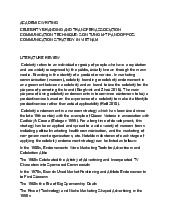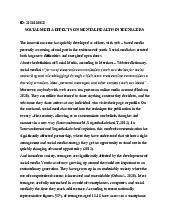

Preview text:
lOMoAR cPSD| 46560390
1. In some countries, many young people choose to work or travel for a year
between finishing high school and starting university studies. Discuss the
advantages and disadvantages.
On the one hand, taking a gap year before university offers several advantages.
The first and foremost benefit is the opportunity to gain practical work
experience. By working during this period, young people can develop crucial
skills that are highly valued in the professional world. For example, through
internships or part-time jobs, students can learn time management, teamwork, and
problem-solving skills. These experiences not only enhance their career prospects
but also provide valuable insights into different industries, helping them make
informed decisions about their career path. Additionally, one's horizons could be
broden through travel during a year off. Exploring different cultures, interacting
with diverse communities, and experiencing new environments can foster
personal growth and enhance global awareness. For instance, volunteering abroad
or participating in cultural exchange programs exposes young people to new
perspectives. This contributes to young adults' perspectives on life as well as
promotes tolerance, adaptability, and intercultural competence.
On the other hand, the trend of working and traveling instead of entering
straight to college could bring potential drawbacks. Firstly, there could be
financial implications associated with taking a gap year. If individuals choose to
travel extensively, the costs may be prohibitive, especially if they do not have
sufficient savings. While travel grants and scholarships are available, not every
student may have access to these resources. Moreover, working throughout the
year may limit opportunities for leisure and exploration, as individuals may need
to prioritize earning income over personal pursuits.
5. Watching television is beneficial vs. watching television has
adverseimpacts on children.
On the one hand, television can be beneficial for children. Educational
programs and documentaries provide learning opportunities, exposing children to
various subjects and expanding their knowledge. These shows often present
information in an engaging manner, making learning enjoyable. Additionally,
specific programs promote creativity and imagination, sparking interest in arts,
science, and other fields. Furthermore, television can serve as a cultural and social
awareness platform, helping children understand different perspectives and fostering empathy.
On the other hand, there are justifications why watching television exerts
adverse detrimental effects on adolescents. Excessive screen time can lead to
sedentary behavior, contributing to health issues like obesity and weak muscles. lOMoAR cPSD| 46560390
Moreover, prolonged television viewing can disrupt sleep patterns, affecting
overall well-being and cognitive functioning. Additionally, exposure to
inappropriate or violent content can negatively influence a child's behavior and
attitudes, leading to aggression or desensitization.
6. Some prefer team sports, others favor individual sports.
On the one hand, team sports offer several advantages to those who participate
in them. Firstly, they promote teamwork and cooperation. In team sports,
individuals learn how to work together towards a common goal, developing their
communication and interpersonal skills. They also learn to trust and rely on their
teammates, fostering a sense of unity and camaraderie. Secondly, team sports
provide opportunities for social interaction. Being part of a team allows
individuals to connect with like-minded individuals who share similar interests
and passions. Strong friendships often form within teams, and the support system
built through these relationships can contribute to enhanced mental well-being
and emotional support. Lastly, team sports teach valuable life lessons such as
discipline, accountability, and resilience. Through rigorous training sessions,
team members learn the importance of commitment and perseverance. They
experience both victory and defeat, understanding the significance of hard work
and determination in achieving success.
On the other hand, individual sports also offer unique advantages to those
who engage in them. Firstly, individual sports foster self-reliance and personal
accountability. Athletes in individual sports are solely responsible for their
performance and progress. This independence allows individuals to set their own
goals and develop a strong sense of self-motivation and discipline. Secondly,
individual sports allow for greater flexibility and adaptability. Players can tailor
their training schedules and routines according to their preferences and
availability. They have more control over their progress and can focus on specific
areas for improvement without being constrained by the dynamics and obligations
of a team. Additionally, individual sports promote introspection and self-
reflection. Athletes often learn to overcome challenges on their own, building
resilience and self-confidence. They develop a deeper understanding of their
strengths and weaknesses, enabling them to make adjustments and strive for continuous self-improvement.




